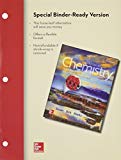
Concept explainers
(a)
Interpretation:
The decomposition of 1.0 mol of the given compound produces 1.5 mol of
(a)
Explanation of Solution
4 moles of
Hence, option A is correct.
(b)
Interpretation:
The decomposition of 1.0 mol of the given compound produces 3.0 mol of
(b)
Explanation of Solution
4 moles of
The number of moles of
Hence, option B is correct.
(c)
Interpretation:
The decomposition of 1.0 mol of the given compound produces 2.5 moles of
(c)
Explanation of Solution
4 moles of
The number of moles of
Hence, option C is correct.
(d)
Interpretation:
The decomposition of 1.0 mol of the given compound produces 1.0 mole of
(d)
Explanation of Solution
4 moles of
The number of moles of
Hence, option D is incorrect and the correct value of the product is 0.25 mol of
(e)
Interpretation:
Whether all the above options (a,b,c,d) are correct or not is to be identified.
(e)
Explanation of Solution
Among the first four options, the (d) part is incorrect. Thus the given statement that“ all the options are correct� is proved to be a wrong statement.
Want to see more full solutions like this?
Chapter 6 Solutions
Combo: Loose Leaf for Introduction to Chemistry with Connect Access Card Chemistry with LearnSmart 1 Semester Access Card
- list at least three quantities that must be conserved in chemical reactions.arrow_forwardWhich of the following statements about chemical reactions is false? l type='a'> When balancing a chemical equation, all subscripts must be conserved. i>When one coefficient is doubled, the rest of the coefficients in (he balanced equation must also be doubled. i>The subscripts in a balanced equation tell us the number of atoms in a molecule. i>The phases in a chemical reaction tell us the nature of the reactants and products.arrow_forwardA natural brine found in Arkansas has a bromide ion concentration of 5.00 × 10−3 M. If 210. g Cl2 were added to 1.00 × 103 L of the brine, determine the limiting reactant. calculate the theoretical yield of Br2 (d = 3.12 g/mL).arrow_forward
- 4.9 Sulfur, S8, combines with oxygen at elevated temperatures to form sulfur dioxide. (a) Write a balanced chemical equation for this reaction. (b) If 200 oxygen molecules are used up in this reaction, how many sulfur molecules react? (c) How many sulfur dioxide molecules are formed in part (b)?arrow_forwardA 0.20 mol sample of magnesium burns in air to form 0.20 mol of solid MgO. What amount (moles) of oxygen (O2) is required for a complete reaction?arrow_forwardIn a laboratory experiment, the reaction of 3.0 mol of H2 with 2.0 mol of I2 produced 1.0 mol of HI. Determine the theoretical yield in grams and the percent yield for this reaction.arrow_forward
- 3.15 Ethanol, C2H5OH is found in gasoline blends used in many parts of North America. Write a balanced chemi- cal equation for the combustion of C2H5OH to form CO2 and HA.arrow_forward4.106 An ore sample with a mass of 670 kg contains 27.7% magnesium carbonate, MgCO3. If all of the magnesium carbonate in this ore sample is decomposed to form carbon dioxide, describe how to determine what mass of CO2 is evolved during the process.arrow_forwardOn Easter Sunday, April 3, 1983, nitric acid spilled from a tank car near downtown Denver, Colorado. The spill was neutralized with sodium carbonate: 2HNO3(aq)+Na2CO3(aq)2NaNO3(aq)+H2O(l)+CO2(g) a. Calculate H for this reaction. Approximately 2.0 104 gal nitric acid was spilled. Assume that the acid was an aqueous solution containing 70.0% HNO3 by mass with a density of 1.42 glcm3. What mass of sodium carbonate was required for complete neutralization of the spill, and what quantity of heat was evolved? (Hf for NaNO3(aq) = 467 kJ/mol) b. According to The Denver Post for April 4, 1983, authorities feared that dangerous air pollution might occur during the neutralization. Considering the magnitude of H, what was their major concern?arrow_forward
 Chemistry & Chemical ReactivityChemistryISBN:9781337399074Author:John C. Kotz, Paul M. Treichel, John Townsend, David TreichelPublisher:Cengage Learning
Chemistry & Chemical ReactivityChemistryISBN:9781337399074Author:John C. Kotz, Paul M. Treichel, John Townsend, David TreichelPublisher:Cengage Learning Chemistry & Chemical ReactivityChemistryISBN:9781133949640Author:John C. Kotz, Paul M. Treichel, John Townsend, David TreichelPublisher:Cengage Learning
Chemistry & Chemical ReactivityChemistryISBN:9781133949640Author:John C. Kotz, Paul M. Treichel, John Townsend, David TreichelPublisher:Cengage Learning Chemistry for Engineering StudentsChemistryISBN:9781337398909Author:Lawrence S. Brown, Tom HolmePublisher:Cengage Learning
Chemistry for Engineering StudentsChemistryISBN:9781337398909Author:Lawrence S. Brown, Tom HolmePublisher:Cengage Learning Chemistry: The Molecular ScienceChemistryISBN:9781285199047Author:John W. Moore, Conrad L. StanitskiPublisher:Cengage Learning
Chemistry: The Molecular ScienceChemistryISBN:9781285199047Author:John W. Moore, Conrad L. StanitskiPublisher:Cengage Learning Introductory Chemistry: A FoundationChemistryISBN:9781337399425Author:Steven S. Zumdahl, Donald J. DeCostePublisher:Cengage Learning
Introductory Chemistry: A FoundationChemistryISBN:9781337399425Author:Steven S. Zumdahl, Donald J. DeCostePublisher:Cengage Learning Introductory Chemistry: A FoundationChemistryISBN:9781285199030Author:Steven S. Zumdahl, Donald J. DeCostePublisher:Cengage Learning
Introductory Chemistry: A FoundationChemistryISBN:9781285199030Author:Steven S. Zumdahl, Donald J. DeCostePublisher:Cengage Learning





